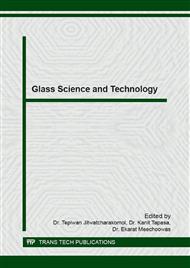p.108
p.113
p.121
p.125
p.130
p.135
p.139
p.145
p.150
The Studies of Contamination from Glass Containers under Various Conditions
Abstract:
The corrosion on glass surfaces causing contamination in the aqueous solutions depend on pH and temperature. This research aims to study the elements leached from the inner glass surfaces that were treated and untreated to aqueous solution. The clear and amber bottles used as the samples were determined the chemical composition by XRF. The samples were treated with 2%, 3% and 5% alum solutions and the hydrolytic resistance test was performed according to ISO 4802-1. The results showed that bottles treated with 3% alum solution gave the most suitable condition to improve the hydrolytic resistance. The treated and untreated bottles were filled with 2% citric acid solution, RO water, and 0.9% sodium chloride solution and kept at 20 and 40°C for 0.125, 1, 2, 4, 10, 20, 40, 60 and 120 days. The pH values of all solutions after ageing were measured and the leached elements – Na, Ca, Al, Cr, Mn, and Pb – in RO water and citric solution were analyzed by AAS. There was significant increase of pH with time at 40°C within 10 days before it had slightly rose to nearly 9.7 of both treated and untreated bottles. However, samples filled with citric solution shows no change in pH value. Na leached from the untreated samples which showed the highest concentration at 2.3 ppm from clear glass and 4 ppm from amber glass respectively. Other elements were not found.
Info:
Periodical:
Pages:
139-144
Citation:
Online since:
July 2016
Keywords:
Price:
Сopyright:
© 2016 Trans Tech Publications Ltd. All Rights Reserved
Share:
Citation:


